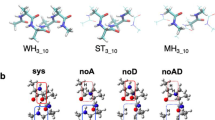Abstract.
An understanding of the amino acid sequence dependent stability of polypeptides is of renowned interest to biophysicists and biochemists, in order to identify the nature of forces that stabilize the three-dimensional structure of proteins. In this study, the role of various collagen triplets influencing the stability of collagen has been addressed. It is found from this study that proline can stabilize the collagen triplet only when other residues are also in the polyproline II conformation. Solvation studies of various triplets indicate that the presence of polar residues increases the free energy of solvation. Especially the triplets containing arginine residues displays a higher solvation free energy. The chemical hardness of all the triplets in collagen-like conformation has been found to be higher than that in the extended conformation. Studies on Gly–X–Y, Gly–X–Hyp, and Gly–Pro–Y triplets confirm that there will be local variations in the stability of collagen along the entire sequence.
Similar content being viewed by others
Acknowledgments.
The authors thank Professor J. Tomasi for his valuable scientific suggestions.
Author information
Authors and Affiliations
Corresponding author
Rights and permissions
About this article
Cite this article
Parthasarathi, R., Madhan, B., Subramanian, V. et al. Ab initio and density functional theory based studies on collagen triplets. Theor Chem Acc 110, 19–27 (2003). https://doi.org/10.1007/s00214-003-0442-6
Received:
Accepted:
Published:
Issue Date:
DOI: https://doi.org/10.1007/s00214-003-0442-6




